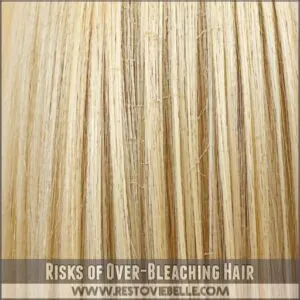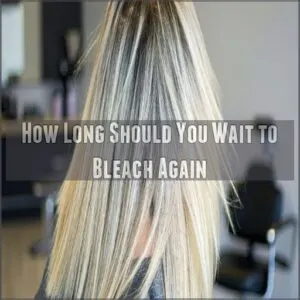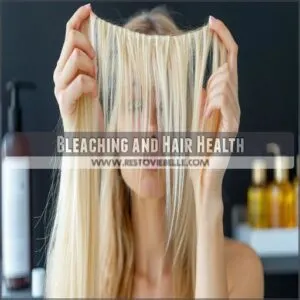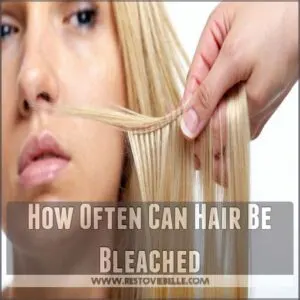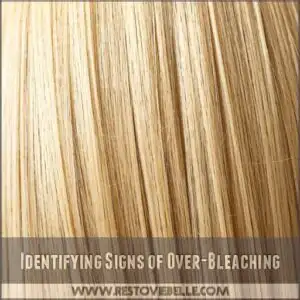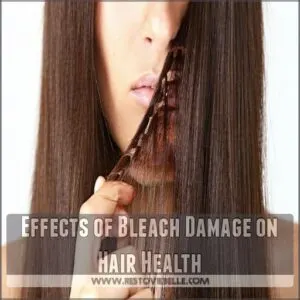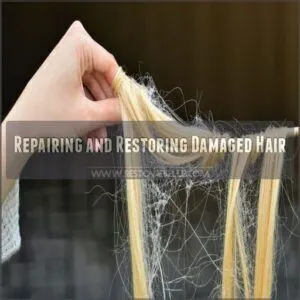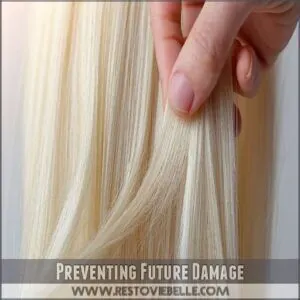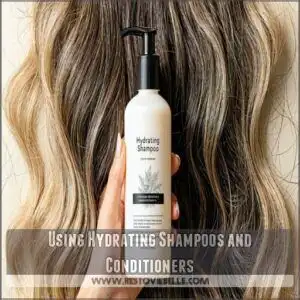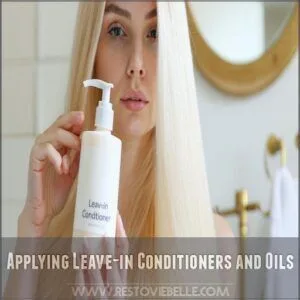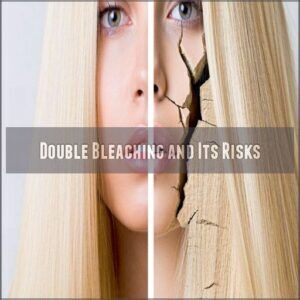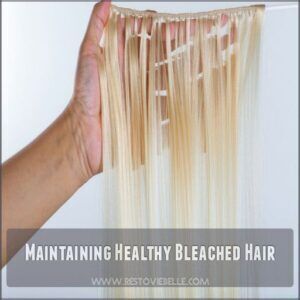This site is supported by our readers. We may earn a commission, at no cost to you, if you purchase through links.
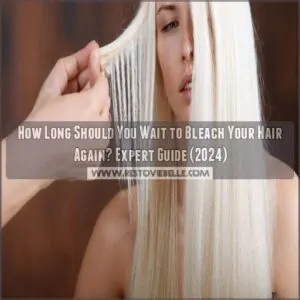
Generally, it’s safe to wait at least two weeks, but your hair’s health should be your guide. Assess its condition—if it feels dry or brittle, give it more time to recover. Think of your hair as a houseplant; nurture it, and don’t overwater it.
For foil highlights, a six to eight-week breather is smart.
If you’re bleaching all over, let your roots grow about ½ inch.
And remember, a good stylist can be your hair’s best friend. Curious about more tips for healthy bleached locks?
Table Of Contents
- Key Takeaways
- Risks of Over-Bleaching Hair
- How Long Should You Wait to Bleach Again
- Bleaching and Hair Health
- How Often Can Hair Be Bleached
- Signs of Bleach Damage
- How to Take Care of Bleached Hair
- Double Bleaching and Its Risks
- Maintaining Healthy Bleached Hair
- Frequently Asked Questions (FAQs)
- How soon can I bleach my hair again?
- How long should you wait before dying your hair after bleaching?
- How often should you bleach your hair?
- Should I bleach my hair again after conditioned hair?
- Can you bleach your hair two days in a row?
- Should you bleach your hair before getting a new one?
- How soon can I bleach my hair again to fix it?
- Can I bleach my hair 2 days later?
- How soon can I bleach my hair after dying it?
- Should I bleach my hair again if it turned orange?
- Can you bleach hair during pregnancy?
- Is it safe to bleach dyed hair?
- What are alternatives to using bleach?
- How does skin sensitivity affect bleaching?
- Can bleach change hair texture permanently?
- Conclusion
Key Takeaways
- You should generally wait at least two weeks between bleaching sessions, but longer if your hair is dry or brittle.
- For foil highlights, wait six to eight weeks.
- Assess your hair’s health before re-bleaching; check for elasticity, split ends, and breakage.
- Consult a professional stylist for personalized advice on bleaching intervals and minimizing damage.
Risks of Over-Bleaching Hair
You’ll need to watch out for the sneaky ways that over-bleaching can damage your hair, from breakage and split ends to that dreaded "cotton candy" texture that nobody wants.
Bleaching can give you that stunning platinum look you’re after, but rushing the process can leave you with weak, brittle strands that might snap faster than your patience with bad hair days.
Damage to Hair Cuticle and Structure
Your hair’s protective cuticle layer takes a serious hit when you bleach too often.
Think of bleaching like opening thousands of tiny armor plates on each strand – it’s not exactly gentle.
Here’s what happens to your hair structure:
- The cuticle scales lift and separate
- Your hair’s protein core gets exposed
- Natural oils struggle to move through damaged layers
This structural damage makes your hair more vulnerable to future chemical processes.
Breakage, Frizz, and Dryness
Bleached strands aren’t just dealing with color changes – they’re facing a daily battle against breakage, frizz, and dryness, all of which are exacerbated by the fact that bleaching strips away natural protective layers.
Let’s break down what you’re up against:
| Warning Sign | What’s Really Happening |
|---|---|
| Snap & Pop | Hair’s protein structure breaking down |
| Cotton Candy Texture | Raised cut causing tangles |
| Straw-Like Feel | Severe moisture loss |
| Endless Frizz | Damaged outer layer rebelling |
Think of bleaching like opening thousands of tiny doors in your hair – they’ll stay open until properly sealed with care.
Importance of Waiting Between Sessions
Giving your hair time to recover between bleaching sessions is like letting a plant grow strong roots.
While dealing with frizz and dryness is challenging, proper timing between treatments makes all the difference.
Here’s what proper waiting periods can do:
- Allows natural oils to replenish and protect your strands
- Gives protein bonds time to strengthen and rebuild
- Reduces the risk of permanent damage and breakage
You’re not just waiting – you’re investing in your hair’s future health.
Professional Guidance and Precautions
Before dreaming of platinum locks, consult a colorist.
They’ll assess your hair’s health, gauge damage, and suggest safe bleaching intervals.
Overdoing it isn’t just risky—it’s a recipe for straw-like strands.
Think of them as your hair’s guardian angel, recommending a care routine to prevent damage and maintain your vibrant color.
| Risk | Consequence |
|---|---|
| Over-Bleaching | Hair Breakage |
| Inadequate Gaps | Scalp Irritation |
| DIY Mistakes | Uneven Color |
| Skipping Care | Persistent Frizz |
How Long Should You Wait to Bleach Again
Waiting between bleaching sessions is essential to keep your hair healthy and prevent the dreaded "cotton candy" effect.
Give your locks some time to recover and plan for your next bleach when they’re ready for more adventures in color!
Factors Affecting Re-Bleaching Time
Your hair type and condition dictate how soon you can bleach again.
Think of it like running a marathon; recovery time is key.
Previous damage, bleach strength, and new growth influence your wait.
Prioritize hair health over haste, ensuring safe hair bleaching intervals.
Balance freedom with caution to sidestep bleach hair damage while maintaining your desired look.
Assessing Hair Health and Condition
You’ll need to size up your hair’s health before bleaching again.
Check hair elasticity by gently stretching a strand; good elasticity means fewer worries.
Examine scalp health and look for split ends, signs of breakage, and hair porosity.
If your hair snaps like dry spaghetti, you might need to rethink your hair bleaching schedule before jumping back in.
Waiting Periods for Different Hair Types
Fine hair? Give it at least eight weeks before you tackle bleaching again.
Thick hair can often handle the six-week mark.
Got damaged or color-treated hair? Extend the break to three months for healthier results.
Natural hair might seem invincible, but a controlled bleaching schedule always protects against hair damage. Waiting makes sure your locks stay vibrant and resilient!
Professional Guidance and Recommendations
Don’t go it alone! A hair stylist consultation is key.
They’ll assess your hair’s health, pinpointing any damage, and advise you on the best time interval between bleaching.
This prevents further issues.
Following their advice on bleach hair frequency and wait time avoids costly color correction later.
Remember, professional advice trumps home bleach risks—your gorgeous hair’s worth it!
Trust a pro for safe bleaching.
Bleaching and Hair Health
Bleaching your hair can be a fun way to switch up your look, but taking care of it’s essential to prevent damage.
You’ll want to be mindful of the risks, like dryness and breakage, and make sure your hair stays healthy with proper pre- and post-bleaching care.
Effects of Bleaching on Hair Health
Bleaching can be a wild ride for your hair.
Frequent bleaching leads to hair breakage, color fading, and pesky scalp irritation.
You’ll also face protein loss, altering your hair’s porosity.
Consider these effects:
- Hair breakage
- Color fading
- Scalp irritation
- Protein loss
- Increased porosity
Keep these in mind to manage bleach hair regrowth and maintain vibrant locks.
Importance of Pre-Bleaching Care
Before jumping into bleaching, think of your hair as a canvas.
Make sure it’s ready with pre-bleaching care: perform a strand test, assess your hair type, and choose the right products and tools.
Protect your scalp and eat a healthy diet to strengthen hair.
This prep work sets the stage for vibrant color with less risk.
| Step | Action |
|---|---|
| Strand Test | Predict color outcome |
| Hair Type Assessment | Understand texture |
| Products and Tools | Choose carefully |
| Protecting Scalp | Use barrier creams |
Post-Bleaching Hair Care and Maintenance
You’ve nailed pre-bleaching care, but what’s next?
Your bleached hair routine is like a plant needing water.
Use nourishing hair masks and toners to refresh color.
Embrace color refreshers and always shield your strands with heat protection.
It’s not just about the bleach hair wait time; it’s about ongoing love and care for that fabulous mane.
Risks of Over-Bleaching and Damage
Your bleached locks need love just like a desert needs rain.
Rushing for that icy glow too soon can lead to hair breakage, dryness, and even hair loss.
To minimize damage, it’s important to assess your hair health before bleaching hair a third time.
Overprocessing is like playing with fire—it weakens hair health and leaves your scalp irritated.
Uneven color might surprise you too.
So, practice patience. Give your hair breathing room and schedule your bleach hair wait time wisely.
How Often Can Hair Be Bleached
So, you’re wondering how often you can bleach your hair without turning it into a brittle, sad mess?
Generally, it’s best to wait at least 4-6 weeks between bleaching sessions, giving your hair a chance to recover and prevent major damage – trust us, your hair will thank you!
Recommended Waiting Periods Between Sessions
Balancing hair health and blond ambitions involves knowing when to bleach again.
It’s like timing a perfect soufflé—rush it, and it collapses.
Ideally, let new growth reach about half an inch before re-bleaching, usually every 6-8 weeks.
Consider hair type, damage level, and color goals.
Consulting hair professionals guarantees a safe, beautiful transformation.
Effects of Frequent Bleaching on Hair Health
Hair breakage and scalp irritation are frequent unwanted gifts from bleaching too often.
To avoid these issues, consider a more spaced-out bleaching frequency and utilizing products specifically designed for hair bleach frequency.
Opting for a more spaced-out bleaching frequency not only guards against hair thinning but also reduces color fading.
Listen to your hair concerns and consult hair professionals to maintain protein levels and make sure hair safety.
Remember, damaged hair deserves a little extra love.
Signs of Over-Bleaching and Damage
Excessive bleaching can leave your hair looking like a scarecrow’s – brittle and frazzled with split ends desperate for rescue. You might notice hair breakage, dryness, or color fading faster than expected.
If your bleached hair feels more straw-like than silky, it’s crying out for nourishment.
Color fading and tangled knots also scream you’ve gone overboard.
Importance of Hair Health Assessment
Imagine your hair’s a sunflower – healthy roots, strong petals.
To keep it blooming, assess hair health before a bleach spree.
Here’s how:
- Check elasticity: If it snaps, it’s like a dry twig; give it moisture.
- Inspect porosity: Absorbing water like a sponge? Time for a break.
- Test strength: Gentle tugs reveal breakage risks.
Signs of Bleach Damage
Noticing your hair feels brittle or is breaking more than usual? These could be signs of bleach damage, signaling it’s time to give your locks a break.
Identifying Signs of Over-Bleaching
Spotting signs of over-bleaching can save your hair from serious woes. Dryness, like brittle straw, creeps in first, accompanied by persistent frizz.
Keep an eye out for split ends and color fading, which may signal impending trouble, and if you notice these signs, consider solutions like Bleach Damage Repair to mitigate the effects.
Hair breakage is a major red flag, so handle with care to prevent irreversible damage.
Understanding these cues helps protect your luscious locks!
Effects of Bleach Damage on Hair Health
So, you’ve spotted those tell-tale signs of over-bleaching. What’s happening to your hair?
Bleach damage weakens your hair’s structure, leading to:
- Increased hair breakage.
- Noticeable dryness and frizz.
- Irritated scalp.
- Faster color fading.
Ignoring these effects can cause more serious problems down the line, like split ends and even protein loss.
Taking care of your bleached hair now is key to keeping it healthy and vibrant.
Repairing and Restoring Damaged Hair
When your hair feels like straw after bleaching, it’s time for some TLC.
Hair masks and protein treatments are your go-to heroes for damaged hair repair, strengthening those fragile strands and boosting moisture retention.
Swap your usual routine for targeted hair care with deep conditioning and dedicated hair treatments.
Your hair will thank you for the extra love and attention!
Preventing Future Damage
You’ve learned to restore damaged hair, but what about stopping future damage?
Here’s your path to prevention: Embrace a healthy hair routine with nourishing hair care products that minimize breakage.
Regular hair health assessments will guide your journey.
Use these damage prevention tips wisely and remember, protecting your bleached hair is like safeguarding a valuable treasure map—essential for a vibrant style!
How to Take Care of Bleached Hair
Caring for bleached hair is like tending to a delicate garden—you need the right tools and a little patience to keep it healthy and vibrant.
Use hydrating shampoos, deep conditioners, and nourishing oils to combat dryness.
Don’t forget to shield your hair from heat and sun for the best results.
Deep Conditioning and Protein Treatments
Spotting bleach damage? It’s time to show your hair some TLC.
Think of deep conditioning and protein treatments as the dynamic duo battling dryness and breakage.
To help you find the right products, check out deep conditioners for bleached hair.
Use DIY treatments weekly to maintain your hair’s strength and softness.
Deep conditioners hydrate while protein treatments strengthen.
Balance is key, so pay attention to your hair’s signals and adjust accordingly.
Using Hydrating Shampoos and Conditioners
Think of hydrating shampoos and conditioners as a tall drink for your thirsty hair.
After bleaching, your locks crave moisture and nutrients.
Hydrating shampoo benefits include nourishing bleached strands and hair moisture retention.
Look for rich ingredients like glycerin and aloe vera in your hair care routine to combat dryness.
Your bleached hair will thank you for this TLC!
Applying Leave-in Conditioners and Oils
Applying a leave-in conditioner or a good hair oil isn’t just like icing on a cake—it’s essential to your daily routine.
Here’s why you need them:
- Benefits: These products lock in moisture, reducing breakage.
- Types: Choose lightweight oils like argan for fine hair.
- Frequency: Use after each wash for the best protection.
Keep your bleached hair nourished and vibrant!
Avoiding Excessive Heat Styling and Sun Exposure
So, you’ve nourished your bleached hair with oils and masks. Great! Now, let’s talk heat. Limit hot tools; they’re a bleached hair’s worst enemy. Always use heat protectants.
To prevent damage from the bleaching process itself, understanding the right 20 Vol developer mixing ratio is essential.
Sun’s a sneaky culprit too, causing excessive dryness and brittle hair. A sun hat‘s your new best friend.
Cool styling is key – think less heat, more shine. Frequent trims keep split ends at bay, promoting overall hair health.
Double Bleaching and Its Risks
Double bleaching involves applying bleach to your hair twice in a short period, which sounds brave but can lead to severe damage and breakage.
It’s essential to wait between sessions to protect your hair and avoid an itchy scalp that might make you reconsider your choices.
Definition and Process of Double Bleaching
To keep your bleached hair looking fabulous, let’s chat about double bleaching.
This process involves applying lightener twice to hit that desired hair color, boosting the lightening effect.
You’ve tried strand testing and know your lightener types, right?
Gently apply and monitor to avoid hair damage risks.
This method isn’t for everyone but can achieve striking results.
Risks of Damage, Breakage, and Scalp Irritation
Double bleaching might sound like a thrilling makeover, but it’s a ticket to hair breakage city.
Your strands become as fragile as spun sugar, leading to damage that no one wants.
Think of your scalp as a sensitive soul; it really doesn’t appreciate the chemical barrage, resulting in irritation.
Mind the over-processing risks and embrace bleached hair care strategies.
Importance of Waiting Between Bleaching Sessions
Sure, you’re tempted to bleach your hair back-to-back for that vibrant color, but pausing between sessions is vital. Eliminate the risk of irreparable damage by giving your hair time to heal.
- Protects hair health: Prevents damage and breakage.
- Maintains color vibrancy: Reduces color fading.
- Reduces hair bleaching risks: Lowers chances of hair damage.
- Encourages healthy regrowth: Supports overall hair recovery.
Maintaining Healthy Bleached Hair
You’ve made the bold choice to bleach your hair, so now it’s all about keeping it healthy and vibrant.
Regular trims, a nourishing hair care routine, and protecting your locks from environmental damage are your best bets for maintaining that dazzling look.
Regular Trims and Haircuts
Regular trims are your secret weapon against hair loss after bleaching.
By snipping those split ends, you’re helping your hair stay strong and healthy.
Frequent haircuts might seem counterproductive if you’re aiming for Rapunzel-length locks, but they actually encourage growth.
Salon visits keep those ends looking fresh, so you can rock vibrant, damage-free hair after every bleach job.
Embracing a Healthy Hair Care Routine
After bleaching, a solid hair care routine is your new best friend.
Think of it as a total makeover for your locks.
Use gentle, sulfate-free shampoos and conditioners.
Regular deep conditioning treatments, maybe even a weekly hair mask, are key.
Hair oil benefits extend beyond shine; they help repair damage.
These hair care products will keep your color vibrant and your hair healthy, minimizing hair loss and promoting hair growth.
Remember, consistent hair maintenance is key to long-lasting results.
Protecting Hair From Environmental Damage
You’ve got your hair care routine down, but protecting it from environmental damage is just as key.
Think of your hair as a delicate flower – too much sun leaves it parched, pollution makes it dusty, and heat styling scorches its petals.
Use sun protection sprays, limit heat tool use, and embrace hats.
Keep your hair vibrant and healthy!
Frequently Asked Questions (FAQs)
How soon can I bleach my hair again?
Picture your hair as a fragile masterpiece; it needs at least 4-6 weeks to recover before another bleach session.
Think of it as giving your hair a mini-vacation to avoid turning brittle and lifeless.
How long should you wait before dying your hair after bleaching?
Wait at least two weeks before dyeing your hair after bleaching to allow for recovery and reduce damage.
Deep conditioning treatments during this time will strengthen your hair, ensuring it’s healthy and ready for color application.
How often should you bleach your hair?
Bleach your hair every 4-6 weeks to allow recovery from damage.
Frequent sessions could lead to breakage and brittleness just as sure as viewers binge-watching a series.
Balance color dreams with hair health for best results.
Should I bleach my hair again after conditioned hair?
Did you know that even conditioned hair needs a break?
Don’t rush it!
Assess your hair’s health. If it’s still dry or brittle, wait at least two weeks before bleaching again.
Patience is key for gorgeous, healthy hair.
Can you bleach your hair two days in a row?
Bleaching your hair two days in a row isn’t recommended.
It can severely damage your hair, making it brittle and prone to breakage.
Give your hair at least 4-6 weeks to recover before another bleaching session.
Should you bleach your hair before getting a new one?
When you’re considering a fresh hairstyle, bleaching before the change can enhance color vibrancy and precision.
Bleaching can damage hair if done too frequently.
Make sure there’s enough recovery time between sessions for the best hair health.
How soon can I bleach my hair again to fix it?
Wait at least four to six weeks before bleaching your hair again.
This gives your hair time to recover, reducing damage.
Keep in mind, healthy hair means better results and fewer hair disasters down the road.
Can I bleach my hair 2 days later?
It’s a bad idea to bleach your hair just 2 days after the first session.
You risk severe damage, breakage, and brittleness.
Wait at least 4-6 weeks to let your hair recover and stay healthy.
How soon can I bleach my hair after dying it?
Think of your hair as a garden; it needs time to recover.
After dyeing, wait at least two weeks before bleaching to minimize damage.
Patience helps maintain hair health and prevents unwanted surprises.
Should I bleach my hair again if it turned orange?
Turning orange doesn’t mean bleach again right away.
Your hair’s in need of some TLC.
A toner can tame the color, and a deep conditioning treatment is a must.
Give it a few weeks before considering another round.
Can you bleach hair during pregnancy?
Bleaching your hair during pregnancy isn’t recommended.
The chemicals mightn’t be safe for your little one.
Talk to your doctor and a hairstylist before making any decisions.
Your health and baby’s are top priority!
Is it safe to bleach dyed hair?
Yes, it’s safe to bleach dyed hair, but proceed cautiously.
Consider potential damage from layers of color processes.
Always perform a strand test first, and maybe consult a pro to minimize risk and maintain hair health.
What are alternatives to using bleach?
While bleaching’s allure is undeniable, you might consider alternatives like natural sun exposure for lightening, lemon juice for highlights, or hair-friendly dye.
These options offer a gentler touch, letting you maintain hair health effortlessly.
How does skin sensitivity affect bleaching?
Sensitivity can cause irritation, redness, and discomfort during bleaching.
If you’ve got sensitive skin, it’s wise to patch test first and consider milder formulas.
Consulting with a colorist helps tailor the process to your needs.
Can bleach change hair texture permanently?
Bleaching can potentially alter your hair texture permanently by weakening the keratin structure, leading to dryness and increased porosity.
Your hair might feel coarser and less manageable, so remember to condition it intensely to minimize damage.
Conclusion
Ultimately, walking the line between vibrant color and healthy hair is like balancing on a tightrope.
Knowing how long you should wait to bleach your hair again is essential to maintaining your hair’s integrity.
Take time, assess your hair’s condition, and consult with professionals to keep your locks luscious.
Remember, whether you’re chasing the perfect blonde or just experimenting, patience and care are your allies.
Embrace a nurturing routine, and your hair will thank you.

